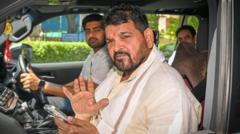In Indian cities, poor footpath conditions heavily impact pedestrian safety and mobility. Activists like Arun Pai in Bengaluru are mobilizing citizens through challenges to document obstacles on footpaths. The larger goal is to advocate for significant changes in infrastructure, emphasizing the need for pedestrian-friendly policies and the creation of Non-Motorised Transport Policies to encourage walking as a sustainable mode of transport.
Footpath Revolution: Advocates Push for Pedestrian-Friendly Urban Environments in India

Footpath Revolution: Advocates Push for Pedestrian-Friendly Urban Environments in India
Citizen activists implement innovative campaigns to enhance footpath conditions and promote walking in Indian cities facing severe pedestrian challenges.
In India, walking as a mode of transport is riddled with challenges, especially in urban environments where the state of footpaths is often dismal. Recently, Arun Pai, a committed citizen activist and founder of Bangalore Walks, launched an initiative called the "world's longest footpath run" in Bengaluru. Participants were encouraged to walk or jog an 11km (8 miles) stretch of footpath, documenting obstacles such as hawkers, garbage, and broken slabs. By quantifying these issues, advocates aim to push for specific changes rather than general complaints about poor infrastructure.
Similarly, movements are taking root in other major cities. Delhi by Cycle promotes cycling and walkability, while in Mumbai, the Walking Project released a 'pedestrian manifesto' calling for better urban planning ahead of state elections. These activists are demanding designated walking spaces, improved safety for pedestrians, and innovative solutions like dedicated hawking zones to ensure smoother navigation for walkers.
Despite government statistics displaying that almost half of Mumbai's population relies on walking, policymakers frequently overlook the needs of pedestrians. In 2022, fatalities among pedestrians accounted for a significant portion of road accidents, highlighting the urgency for safer footpaths. Authorities often apply temporary fixes, neglecting the necessity for a cohesive pedestrian infrastructure to accommodate high foot traffic.
Research from Chennai showcases the benefits of investing in footpaths, revealing that improved walkability significantly influences daily transportation choices, encourages eco-friendly practices, and promotes economic stability among lower-income demographics. This indicates a growing intersection of urban design, health, and social equity linked to pedestrian infrastructure.
Citizen activists stress that the discourse surrounding footpaths often lacks context, as many have not experienced pedestrian-friendly environments elsewhere. This absence of a benchmark leads to complacency about the pressing need for safe walking spaces in cities.
Experts suggest a paradigm shift in urban planning, advocating that policymakers focus on pedestrian infrastructure to genuinely address traffic congestion issues rather than compromising footpath space. The need for state-level adoption of guidelines from the Indian Road Congress and the implementation of Non-Motorised Transport Policy is essential to ensure cities accommodate pedestrians and cyclists alike.
The commitment to transforming India’s urban landscapes continues to grow, as citizen activists leverage community engagement and policy advocacy to reclaim spaces for those navigating the city on foot. Walking, as deemed by advocates, represents the most sustainable means of urban transportation and is instrumental in shaping a greener future for cities in India.





















